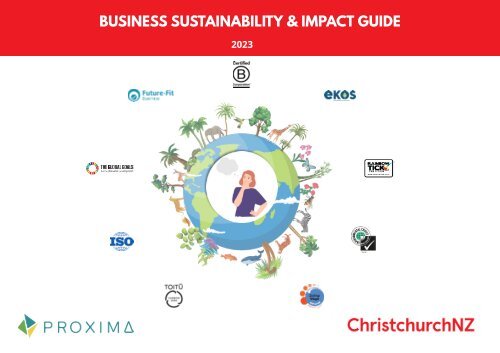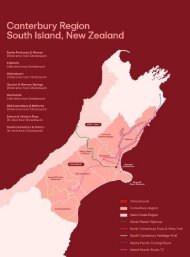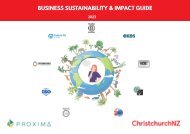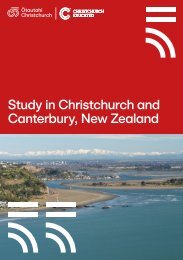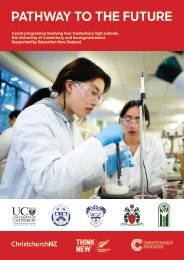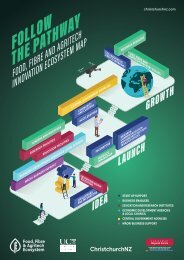SME Sustainability & Impact Guide 2024
You also want an ePaper? Increase the reach of your titles
YUMPU automatically turns print PDFs into web optimized ePapers that Google loves.
BUSINESS SUSTAINABILITY & IMPACT GUIDE<br />
2023
CONTENTS<br />
1. Who is this guide for?.........................................................<br />
2.What do we mean by ‘sustainability’?.................................<br />
3.Why should businesses address sustainability?....................<br />
4.Where do I start?...............................................................<br />
5. Levers and barriers: Lessons from businesses………………….<br />
6.What tools or framework should I use?...............................<br />
7.Overview of the most common tools and frameworks……….<br />
8.Other tools and frameworks being used in Aotearoa ……….<br />
• Big businesses………………………………………………………………<br />
• Multi-industry………………………………………………………………<br />
• Construction / property …………………………………………………<br />
page 3<br />
page 4<br />
page 11<br />
page 12<br />
page 14<br />
page 16<br />
page 17<br />
page 18<br />
page 29<br />
page 31<br />
page 33<br />
• Tourism………………………………………………………………………. page 35<br />
• Primary industries………………………………………………………... page 36
WHO IS THIS GUIDE FOR?<br />
Business leaders, owners and managers wanting to…<br />
understand how a focus<br />
on sustainability can<br />
create value for their<br />
business…<br />
begin developing a<br />
strategy and plan for<br />
integrating<br />
sustainability into their<br />
business…<br />
learn about some of the<br />
levers and barriers that<br />
other businesses have<br />
experienced in their<br />
own sustainability<br />
journeys…<br />
get guidance on which<br />
sustainability<br />
certifications and<br />
frameworks are most<br />
useful for their<br />
business.
WHAT DO WE MEAN BY ‘SUSTAINABILITY’?<br />
DEFINITION<br />
Profitable enterprise and meaningful work that is<br />
FUTURE<br />
good for the environment, and good for people.<br />
Most of us enjoy a good standard of living. By harnessing natural resources and working together, human society around the wo rld has come<br />
a long way in the last 200 years. Yet, whilst great wealth has been created, many people still live in poverty – both here and in other<br />
countries; and the natural systems we all depend on are deteriorating and disappearing at alarming rates.<br />
<strong>Sustainability</strong> is about making sure the natural, social and economic systems we depend on are protected for ourselves and fut ure<br />
generations, whilst leaving no-one behind. A sustainable future can be described as one that is fair and just, offers economic opportunities<br />
for all, and where nature can thrive indefinitely to support Earth’s rich web of life.<br />
We need to think and act differently.<br />
Our economy, society and<br />
the environment should not<br />
be thought of as separate<br />
things.<br />
They are completely connected and<br />
interdependent.<br />
A vibrant economy depends upon a stable<br />
and thriving society, and neither society nor<br />
the economy can flourish without a healthy<br />
environment to underpin them.
WHAT DO WE MEAN BY ‘SUSTAINABILITY’?<br />
IMPACTS<br />
How does your business depend on natural, social and economic systems?<br />
It is likely that your business will have both positive and negative impacts. To understand what we mean by sustainability, l et’s look at a<br />
few examples. When we talk about sustainability, we mean…<br />
…Protecting and restoring freshwater.<br />
Every product you sell and every raw ingredient you buy depends on the availability of<br />
freshwater. Freshwater is fundamental for life for everything everywhere. It is used in<br />
manufacturing, for transport, to grow food, and to drink!<br />
Can you think of any ways in which products, inputs or activities<br />
related to your business may impact freshwater? Let’s say I run<br />
a business that manufactures and retails clothes…<br />
Upstream <strong>Impact</strong>s<br />
Direct <strong>Impact</strong>s<br />
Downstream <strong>Impact</strong>s<br />
Harmful chemicals may<br />
spill into waterways<br />
during the dyeing of<br />
fabrics that my company<br />
purchases. Does the<br />
upstream manufacturer<br />
have good environmental<br />
safeguards in place?<br />
Our water use is minimal,<br />
being only for drinking<br />
and basic sanitation. So,<br />
whilst we can encourage<br />
our people to use water<br />
efficiently, the impact is<br />
not significant.<br />
Plastic microfibre<br />
is released from synthetic<br />
jackets when they are<br />
washed and proceed<br />
through water treatment<br />
plant filters,<br />
ultimately polluting<br />
marine and freshwater<br />
systems.
WHAT DO WE MEAN BY ‘SUSTAINABILITY’?<br />
IMPACTS<br />
How does your business depend on natural, social and economic systems?<br />
It is likely that your business will have both positive and negative impacts. To understand what we mean by sustainability, l et’s look at a<br />
few examples. When we talk about sustainability, we mean…<br />
…Using renewable energy.<br />
Since we began digging up and burning oil, coal and gas, the world has benefitted hugely<br />
from cheap and abundant energy. The energy to build cities, move goods, power our homes,<br />
and fly us around the world. Harnessing this fossil energy has completely revolutionized our<br />
world. But the carbon dioxide released from burning fossil fuels traps heat in our<br />
atmosphere, which causes climate change. Climate change is already creating more extreme<br />
weather, heating our oceans, and adversely affecting environmental systems around the<br />
world. We must quickly shift to renewable energy, like hydro, wind, and solar.<br />
Can you think of any ways in which products, inputs or activities related to<br />
your business may contribute to climate change? Let’s say I run a business<br />
that imports, distributes and retails wine…<br />
Upstream <strong>Impact</strong>s Direct <strong>Impact</strong>s Downstream <strong>Impact</strong>s<br />
Wine imported from<br />
Australia will cause far less<br />
CO2 emissions than wine<br />
imported from France. Air<br />
freight should be avoided<br />
where possible. Sourcing<br />
from closer is better.<br />
Switching to LED lights and<br />
energy efficient fridges<br />
across our stores saves an<br />
enormous amount of<br />
energy and, therefore,<br />
money as well as CO2<br />
emissions.<br />
Glass can be recycled but<br />
the furnaces require a huge<br />
amount of energy to melt<br />
the glass. If the energy isn’t<br />
renewable, a significant<br />
amount of CO2 is released.
WHAT DO WE MEAN BY ‘SUSTAINABILITY’?<br />
IMPACTS<br />
How does your business depend on natural, social and economic systems?<br />
It is likely that your business will have both positive and negative impacts. To understand what we mean by sustainability, l et’s look at a<br />
few examples. When we talk about sustainability, we mean…<br />
…Helping people to live healthy and fulfilling lives.<br />
When people are able to meet their fundamental human needs, like nutrition, friendship,<br />
safety, participation, creativity, etc., we foster a society that enhances wellbeing and trust.<br />
Trust is the cornerstone of a functioning society. When people face barriers to their basic<br />
needs, trust begins to erode. Transactions become more challenging, economies become less<br />
efficient, and life becomes harder. Importantly, people who can’t meet their basic needs<br />
aren’t going to spend much time thinking about how they can save the environment.<br />
Can you think of any ways in which products, inputs or activities related to<br />
your business may help or hinder people to live healthy and fulfilling lives?<br />
Let’s say I’m the manager of a hotel…<br />
Upstream <strong>Impact</strong>s Direct <strong>Impact</strong>s Downstream <strong>Impact</strong>s<br />
By purchasing fair trade<br />
goods, we can ensure our<br />
consumable items are<br />
produced by people paid<br />
a decent wage, working in<br />
decent conditions.<br />
We pay all our staff at least<br />
the living wage. We also<br />
offer $500 per employee per<br />
year for education and<br />
development. We also<br />
support local causes where<br />
we can.<br />
By creating a good place to<br />
work, our staff are happier<br />
and healthier in their personal<br />
lives. They contribute to and<br />
participate actively in their<br />
local communities.
WHAT DO WE MEAN BY ‘SUSTAINABILITY’?<br />
IMPACTS<br />
How does your business depend on natural, social and economic systems?<br />
It is likely that your business will have both positive and negative impacts. To understand what we mean by sustainability, l et’s look at a<br />
few examples. When we talk about sustainability, we mean…<br />
…Eliminating waste.<br />
The amount of stuff we produce on a given day is mind blowing. Plastics, chemicals, textiles,<br />
metals, electronics, appliances, furniture, food, building products and so on. Where does all<br />
this stuff go? Too often it ends up at a landfill, where it releases toxins, emits harmful gas<br />
and is ultimately wasted. Is the supply of raw materials to make this stuff limitless? No, and<br />
digging up raw materials is expensive and can harm ecosystems. What happens when all<br />
this stuff enters our soils, waterways, oceans, and our air? Rivers are no longer swimmable,<br />
soil loses its fertility, fish species die, our air becomes polluted. We must keep our resources<br />
in circulation for as long as possible to be more efficient, less polluting and save costs.<br />
Can you think of any ways in which products, inputs or activities related to<br />
your business may create or avoid waste? Let’s say I run a business that<br />
manufactures fitness equipment…<br />
Upstream <strong>Impact</strong>s Direct <strong>Impact</strong>s Downstream <strong>Impact</strong>s<br />
We only use recycled<br />
metals, so upstream<br />
impacts from mining<br />
metals are avoided. We<br />
specify recycled plastic<br />
where feasible.<br />
Even with precision cutting,<br />
there are still off-cuts and<br />
trimmings that we send to<br />
landfill. We avoid single-use<br />
plastic packaging.<br />
We have made our products<br />
modular and accessible, which<br />
means they can be easily repaired<br />
and upgraded. This keeps our<br />
products alive for twice as long as<br />
our competitors’ and reduces<br />
waste.
WHAT DO WE MEAN BY ‘SUSTAINABILITY’?<br />
FACTS<br />
This inner red circle indicates the safe space within which our activities have an acceptable impact. In<br />
Aotearoa New Zealand, we currently exceed these safe limits contributing to climate change, biodiversity<br />
loss, pollution, and degradation of land and water systems.<br />
Knowing how your business activities contribute to these pressures is not always obvious. Many of the<br />
frameworks we outline later in this guide can help you.<br />
Rockström, J., et al., n.d., A Safe<br />
Operating Space for New Zealand/<br />
Aotearoa, Translating the planetary<br />
boundaries framework<br />
At the global level, environmental sustainability can be measured as an ecological<br />
footprint. It measures the amount of the Earth’s natural resources consumed to support<br />
human society. Earth Overshoot day marks the day of the year when the ecological<br />
footprint of human society exceeds what the Earth can sustainably replenish.<br />
In 1987 Earth Overshoot day occurred on 23rd October. After that day, humans used more<br />
of the planet's resources than the planet could provide - incurring a sort of ecological<br />
debt. In 2023, Earth Overshoot day occurred almost three months earlier on 2 nd August -<br />
so the situation has deteriorated, rather than improved, over the last 35 years. For<br />
Aotearoa New Zealand, Overshoot day occurred on 19 th April 2023. If everyone lived like<br />
us, we’d need the equivalent of three Earths to live within environmentally sustainable<br />
limits!
WHAT DO WE MEAN BY ‘SUSTAINABILITY’?<br />
FACTS<br />
The United Nations Sustainable Development Goals provide a broader indication<br />
of our progress towards sustainability. Aotearoa New Zealand has adopted these<br />
goals. We have made progress but in some areas we need to do more.<br />
For example, we are only just<br />
over half of the way to ending<br />
poverty for all…<br />
…and the availability and sustainable management of<br />
clean water and sanitation is getting worse.<br />
Achieving the SDGs is about creating a more resilient and healthy society; and<br />
businesses can help. The more we apply ourselves, the easier sustainability gets<br />
and the brighter our future becomes for all!
WHY SHOULD BUSINESSES ADDRESS SUSTAINABILITY ISSUES?<br />
CUSTOMER<br />
DEMAND<br />
Increasingly, consumers and business customers demand products and services that demonstrate good ethics, sustainability and<br />
social responsibility. Green-washing (over-inflated or false sustainability claims), whether intentional or not, can cause serious<br />
harm to reputation and goodwill.<br />
AVOID RISK<br />
Domestic and international regulation is tightening the baseline requirements for business sustainability performance. Banks and<br />
insurers are applying higher costs where sustainability risks are not addressed. And people’s values are changing their spending<br />
patterns. Proactively managing these risks is easier, cheaper, and avoids unnecessary headaches.<br />
PASSIONATE<br />
WORKERS<br />
A Kantar Better Futures survey found that 75% of Kiwis want to work for a company that is socially and environmentally<br />
responsible. Authentically integrating sustainability into your business helps attract and retain talented and motivated people.<br />
COST<br />
SAVINGS<br />
Good sustainability practices enable you to identify efficiencies across the value chain. Think reduced fuel costs, energy savings,<br />
higher performing and longer lasting materials, higher asset resale value, and so on. Banks also offer lower rates on finance for<br />
companies which commit to sustainability targets<br />
MARKET<br />
ACCESS<br />
Increasingly, large companies, government bodies and councils include sustainability performance in their tender process. Their<br />
sustainability procurement performance depends on your business sustainability performance. <strong>Sustainability</strong> credentials can also<br />
improve access to competitive international markets.<br />
INCREASED<br />
INNOVATION<br />
A sustainability lens augments how you think about value creation, particularly for the long-term where gains can be greatest. It<br />
can drive innovation and design for better products and services that your customers prefer.<br />
ENDURING<br />
GOODWILL<br />
Consumer sentiment pivots quickly in the age of instant information. An integrated sustainability approach defends your social<br />
licence and customer goodwill against hard-to-predict changes in consumer and societal attitudes.
WHERE DO I START?<br />
1) If you haven’t already, spend some time developing your understanding of sustainability so you can help others be more aware.<br />
Here are four low-effort resources…<br />
<strong>Sustainability</strong> Illustrated<br />
YouTube channel<br />
Drawdown<br />
Book<br />
Ray Anderson’s TED Talk<br />
The Business Logic of<br />
<strong>Sustainability</strong><br />
Grab a coffee and talk to others<br />
in your industry<br />
A series of enjoyable, credible, and<br />
to-the-point illustrated videos.<br />
An eye-opening list of solutions to<br />
climate change in bite-sized chunks.<br />
An inspiring yet grounded example of<br />
how a carpet business levered<br />
sustainability for profit.<br />
An underrated approach to<br />
understanding barriers and<br />
opportunities for your business.<br />
2) Engage your team.<br />
Your team are a great source of information to help get you thinking about your sustainability strategy. What do they know ab out sustainability? How might<br />
they see it in relation to their roles? How does it fit with your core business purpose? Creating a partnership with your te am around sustainability helps to<br />
‘kick the flywheel’ into motion and build momentum. Helping to upskill your team about what sustainability ‘is’ will create a common understanding so you<br />
can identify what sustainability ‘means’ for your business.<br />
3) Review the most relevant business sustainability tools or frameworks.<br />
<strong>Sustainability</strong> is a big topic, with many dimensions and uncertainties, making it notoriously tricky to navigate. This is wher e sustainability tools and<br />
frameworks come into bat. Broadly speaking, they help businesses: identify the impacts they have on people and the planet; prioritise the impacts they<br />
should focus on; guide them to reduce those impacts; and credibly communicate progress to stakeholders. There are many different tools and frameworks<br />
available to help. Some are more useful in different industries. Some are wide-reaching and holistic. Some focus just on specific issues. Some are less<br />
recognised than others. And some require more effort than others to obtain full value.<br />
The second half of this guide is designed to help you choose which sustainability tool or framework is the best fit for your business. This will help you<br />
address the most useful issues, communicate relevant information, and create more sustainable value in ways that benefit the business financially.
WHERE DO I START?<br />
4) Decide on a few sustainability topics to focus on.<br />
After talking with your team, considering the most relevant tools or frameworks, and having a chat with contacts in your indu stry, you should have a<br />
rough idea of the issues that are most important to your business. For example, an IT business will probably find it has few environmental impacts<br />
but can reduce its energy use and/or focus on staff wellbeing. A hair and beauty salon will probably find that choosing produ cts with<br />
environmentally-friendly certifications will help it reduce its impacts most effectively whilst creating points of difference for marketing.<br />
On a page, note down the two or three sustainability areas that you think are most relevant (the tools and frameworks in the second half of this<br />
guide will usually indicate what these are). Then brainstorm a few actions or initiatives that your business could take to he lp reduce its negative<br />
impacts and increase its positive impacts.<br />
5) Write a simple plan.<br />
Once you’ve identified a few initiatives, write down a simple plan for actioning them. Try and specify who, what and by when. For example:<br />
- Ask Sarah to replace all warehouse lights with LED bulbs by September<br />
- I will research upstream manufacturers with sustainability certifications that we might work with so we can discuss this at n ext month’s strategy<br />
meeting.<br />
- I will ask our accountant to tell us at next week’s finance meeting whether paying the living wage to all staff is affordable for us.<br />
- Ask Bill to get a quote for installing solar panels at our processing plant by June and estimate what the energy and cost sav ings might be over time.<br />
- Talk to our management team on Friday about whether we could link remuneration benefits to specific sustainability goals.<br />
6) Share your plan with the team and make a start.<br />
You don’t have to solve everything at once. Just get started on a couple of things and see how you get on. The more you develop your plan with your<br />
team, the easier it will be to get things done because your team will understand why they are doing something new or different.
LEVERS AND BARRIERS: LESSONS FROM BUSINESSES<br />
LEVERS<br />
Write down what ‘good’ looks like<br />
<strong>Sustainability</strong> issues are wide-ranging. It is easy to get bogged down trying to figure out what to do.<br />
After you’ve done a bit of research, looked at a couple of tools/frameworks, try and write down<br />
what your business would look like if it had achieved its sustainability goals. This sets a waypoint<br />
that you can use to check your progress over time. You can ask, ”if we get this certification, or if we<br />
make this change, will we be moving closer to what good looks like for our business? ”<br />
Collaborate and share<br />
Most of the sustainability challenges and opportunities that you’ll come up against will be the same<br />
that other businesses are facing. For example, the cost and effort involved in providing a repair<br />
service for appliances might be easier if several similar businesses partnered together to establish a<br />
shared repair service. Similarly, electronics/IT businesses could offer computer and tech recycling to<br />
customers more easily if they bundled used equipment together; making the process more appealing<br />
to a local tech recycling organisation.<br />
Invest in your team<br />
Implementing a sustainability strategy is much<br />
easier when your team understands why<br />
sustainability matters to the business and how<br />
sustainability is part of their role. Make sure you<br />
develop a sustainability plan with your team, not<br />
for your team. Invest in their knowledge and give<br />
them ownership over the strategy.<br />
Market your progress transparently<br />
Being honest and upfront about how your business is<br />
tackling sustainability is good for business. People<br />
have inbuilt ‘bullshit’ detectors and can tell if a<br />
business is claiming to be green when in fact it isn’t.<br />
Honest explanations of progress build consumer trust<br />
and loyalty. Increasingly, local councils, central<br />
government and private businesses are prioritising<br />
sustainability performance in their procurement<br />
practices. Marketing your sustainability performance<br />
transparently will open up new business opportunities.<br />
Data is your friend<br />
Businesses often say, “we wish we had<br />
started measuring our sustainability<br />
performance earlier”. Keeping simple<br />
records of things like, kWh of<br />
electricity used, kg of recycled material<br />
collected, litres of water saved, etc.,<br />
means you can compare progress<br />
against a baseline starting point. Data<br />
clarifies progress and measures<br />
benefits, which is valuable for<br />
marketing.
LEVERS AND BARRIERS: LESSONS FROM BUSINESSES<br />
BARRIERS<br />
Don’t let perfection get in the way of progress<br />
It’s tempting to take on every aspect of sustainability and try to reduce all your business’s impacts.<br />
However, this approach risks stretching you and your team too thinly, making it difficult to show<br />
progress on anything specific. Start with a basic plan focusing on just a couple of important things<br />
to begin with. It’s easier to manage and often helps create a bigger impact and more opportunities<br />
sooner.<br />
Don’t be afraid to test and pivot<br />
As with all things in business, some ideas succeed, some fail, and some are<br />
more challenging than expected. It’s all part of the challenge. If an initiative<br />
isn’t bearing fruit, talk with your team and try to understand what might be<br />
going wrong. If you find that the goal you are working towards is out of reach or<br />
your approach isn’t working, it’s okay to pivot. This is the value of trial periods<br />
and pilot projects.<br />
Beware top-down strategies<br />
Developing a strategy and plan without input<br />
from your team and then asking them to<br />
implement it rarely works. Generally, your<br />
team will feel less ownership and investment<br />
in the initiatives. Instead, ask your team how<br />
they would go about saving water,<br />
separating waste streams, coordinating with<br />
suppliers, for example, and then develop a<br />
plan taking their ideas and recommendations<br />
into account.<br />
Don’t worry if some don’t jump on board at the start<br />
The adoption bell-curve is a useful reminder that people have different levels of interest and<br />
energy for change. Whilst it’s important to take an inclusive approach to maximise the<br />
success of sustainability initiatives, it will always take time for late adopters and laggards<br />
to join in. And some laggards may never join! Working with a coalition of the willing first,<br />
and ensuring that group is as large as possible, by making it easy and attractive to join,<br />
ensures momentum for those that want to move ahead. Sharing the value of progress, whilst<br />
incentivising and rewarding success without shaming the later adopters, has proven<br />
effective for many businesses to encourage more and more people to join the leaders and<br />
accelerate the sustainability journey.
WHAT TOOL OR FRAMEWORK SHOULD I USE?<br />
QUESTIONS<br />
There is no one size that fits all.<br />
There are many different sustainability tools, certifications, and frameworks. Here are some good questions to set you in the right direction.<br />
Which audiences do we want to<br />
engage: customers, staff, investors,<br />
regulators? Which tools or frameworks<br />
will help me best communicate with<br />
them? Who else is using them?<br />
Are we more interested in managing<br />
the sustainability performance of our<br />
company as a whole; or specifically<br />
demonstrating the sustainability<br />
credentials of a product or service?<br />
Is it more valuable for us to focus<br />
on a specific issue first, like<br />
carbon, waste or staff wellbeing?<br />
What do our most important<br />
customers or partners expect?<br />
What information do we need<br />
to collect to show that?<br />
How much is this going to cost? How<br />
much effort is involved? Will it help us<br />
achieve our strategic business<br />
objectives? Do we have the internal<br />
capability?<br />
Are we looking for a holistic<br />
framework that can help us plan to<br />
improve the environmental, social,<br />
cultural and governance aspects of<br />
our business?
WHAT TOOL OR FRAMEWORK SHOULD I USE?<br />
CONSIDERATIONS<br />
ORGANISATION OR PRODUCT FOCUS STRATEGIC OR MANAGEMENT FOCUS BUSINESS OBJECTIVES & GREENWASHING<br />
vs<br />
vs<br />
&<br />
Are customer relationships based on your<br />
business’ brand and reputation; or primarily<br />
focused on the product or service you deliver?<br />
• Consumer facing businesses selling products<br />
may well lean towards a product certification<br />
as a first step; but should not overlook that<br />
customers will want to see consistency<br />
between a product brand and the<br />
organisation behind it.<br />
• Businesses that identify more as an<br />
organisational brand, such as construction,<br />
retail or service companies, are likely to<br />
benefit more from a framework that drives<br />
organisational improvement.<br />
• For some, particularly those relying more<br />
heavily on sustainability values and branding,<br />
both approaches may be appropriate.<br />
• Frameworks like ISO and Enviromark are<br />
designed as environmental management<br />
systems. These focus more on internal<br />
processes and controls and represent a<br />
customer promise of appropriate internal<br />
standards.<br />
• On the other hand, B Corp and the Future-<br />
Fit Business Benchmark are more focused<br />
on continual improvement towards<br />
strategic goals covering a full range of<br />
sustainability issues.<br />
• Increasingly, some customers regard<br />
environmental management systems like<br />
ISO as an entry-level market requirement;<br />
so, it's important to know what your<br />
current or desired customers and markets<br />
are most interested in.<br />
Businesses will get the most value out of the tools and<br />
frameworks that align with their vision and help achieve<br />
longer-term strategic objectives.<br />
• These might include attracting talented staff, reaching into<br />
new markets, developing a particular brand essence or<br />
managing specific issues and risks.<br />
• It's important for boards, leaders and team members to be<br />
involved in decision-making to ensure collective<br />
understanding of the approach. Regardless of which<br />
approach is adopted, businesses which fail to live the values<br />
of a certification or sustainability framework, or simply use<br />
it to bolster their green credentials without authentically<br />
walking the talk, run a serious risk of being called out.<br />
• The public and customers are increasingly savvy about what<br />
genuine sustainable practices look like and what is<br />
greenwash (putting lipstick on a pig). Businesses that are<br />
seen to be greenwashing will lose trust with their customers,<br />
staff and partners which, will erode business value.
OVERVIEW OF THE MOST COMMON TOOLS AND FRAMEWORKS<br />
There are literally hundreds of different ecolabels, certifications, management systems and measurement frameworks addressing sustainability. Some are sector<br />
specific (with over 100 for food and beverage alone) and others can be used for any product or business. This guide covers most of the tools and frameworks more<br />
commonly used in Aotearoa New Zealand. Broadly, they fall into 3 buckets…<br />
Plan, Measure and<br />
Manage.<br />
Greenhouse gas<br />
Measurement and<br />
Management.<br />
Specific<br />
<strong>Sustainability</strong> Issue.<br />
• Support sustainability planning, measurement<br />
and management across a broad range of<br />
sustainability aspects.<br />
• Can be thought of as more ‘organisation-wide’<br />
frameworks.<br />
• Strategic in nature, taking a longer-term focus.<br />
• Require engagement from across the business.<br />
• Usually become embedded in the businesses<br />
DNA over time.<br />
• Often recognised and used by organisations<br />
globally.<br />
• Some provide external certification.<br />
• Specifically designed to support the<br />
measurement and management of an<br />
organisation’s greenhouse gas emissions.<br />
• Help with the technical side, like getting the<br />
right data, aligning with accepted accounting<br />
practices, and setting targets.<br />
• Provide external certification/audit to provide<br />
accountability.<br />
• Can help underpin the GHG aspects of<br />
broader frameworks from the ‘Plan,<br />
Measure, Manage’ bucket.<br />
• Designed to tackle specific issues under<br />
the umbrella of sustainability, like fair<br />
wages, product efficiency, organically<br />
grown, product recyclability, and so on.<br />
• They often have a certification pathway<br />
via an audit or review, which gives<br />
credibility to claims.<br />
• Often used in tandem with each other.<br />
• Useful for access to markets that<br />
require evidence of specific standards.<br />
• Can help underpin various aspects of<br />
broader frameworks from the ‘Plan,<br />
Measure, Manage’ bucket.
OVERVIEW OF THE MOST COMMON TOOLS AND FRAMEWORKS<br />
B Corp<br />
bcorporation.com.au<br />
Best suited for:<br />
Businesses of any size<br />
Insert logo<br />
B <strong>Impact</strong> Assessment is an online tool that businesses can use to assess, compare and improve impact on workers,<br />
community, environment and customers. The SDG Action Manager provides an overview of the impact on each of the SDGs.<br />
To become a certified B Corp, a company must complete the B <strong>Impact</strong> Assessment (BIA), earn a minimum score of 80<br />
points and have the assessment verified by the international non-profit B Lab.<br />
Cost and effort involved<br />
• Free to use the BIA self-assessment<br />
• Initial certification costs approximately $4,250 for businesses with annual revenue of below $2M, with 40% reduced equity pricing for<br />
Māori businesses.<br />
• Reasonable initial effort required to gather data for self-assessment.<br />
Pros<br />
Cons<br />
• Self-assessment generates clear next steps for measurable performance<br />
improvement.<br />
• B Corp has an increasingly recognised brand with consumers which can make<br />
certification a useful marketing tool for businesses wanting to demonstrate<br />
commitment to their customers.<br />
• Clear steps to certification following self-assessment<br />
• Affordable and low effort for small uncomplicated businesses<br />
• Well-recognised certification globally with increasing profile in NZ<br />
• Reasonable effort required to undertake self-assessment<br />
(from 30 min for a small business to 2 years for a global<br />
business - depends on the size and complexity of the<br />
business)<br />
• Does not offer a methodology for evaluating net-positive<br />
social or environmental impact<br />
Who else is using it?<br />
Kathmandu, Kiwibank, Synlait, Ethique, Eagle Direct, Flashworks Media, Banqer, Grow Good, Brown Bread, Trineo, Like-minded,<br />
Ngātahi Communications, Manukora (over of 100 certified B Corps in NZ)
OVERVIEW OF THE MOST COMMON TOOLS AND FRAMEWORKS<br />
Future-Fit Business Benchmark<br />
futurefitbusiness.org<br />
Best suited for:<br />
Businesses of any size<br />
The Future-Fit Business Benchmark offers a holistic framework for assessing organisational and product performance against a full range of<br />
sustainability issues. The Benchmark’s 23 Break-Even Goals assess and measure progress towards 100% sustainable performance across all relevant<br />
aspects of sustainability; whilst the 24 Positive Pursuits provide an approach for evaluating and communicating different aspects of positive impact.<br />
The Benchmark is designed to highlight a clear pathway of next step actions from measuring performance, with progress scores of between 0% to<br />
100% to identify a point of break-even sustainability. The Benchmark’s Break-Even Goals and Positive Pursuits are all mapped to the SDGs to easily<br />
highlight where business activities are contributing to various SDGs.<br />
Cost and effort involved<br />
• Free with a wide range of open-source guides and materials available online, as well as an open online community network<br />
• A reasonable amount of initial effort is required to gather data for self-assessment<br />
Pros<br />
Cons<br />
• Self-assessment based on data input generates clear next steps for<br />
measurable performance improvement<br />
• Concrete progress measures from 0 to 100% across 23 Break-Even Goals<br />
supports innovation and business model evolution for sustainability<br />
• Holistic approach with simple prioritisation tool for more targeted focus<br />
• Comprehensive free guides, supporting materials and tools to identify most<br />
relevant areas of risk<br />
• Designed to enable 3rd party verification and audit where desired<br />
• Free online Changemaker Community is available as a global support and<br />
peer-learning network<br />
• High-level self-assessment app available through Virgin Money<br />
• Initial self-assessment requires a reasonable amount of<br />
effort and specific data which may be onerous for smaller<br />
organisations<br />
• No detailed online assessment tool available<br />
• Does not offer a certification<br />
Who else is using it?<br />
Tourism Holdings Ltd, Plant and Food Research, Grant Thornton, NZ Tech, Tumblar, Ziptrek Ecotours, Proxima
OVERVIEW OF THE MOST COMMON TOOLS AND FRAMEWORKS<br />
UN Sustainable Development Global Goals<br />
globalgoals.org<br />
Best suited for:<br />
Government, businesses of any size<br />
In 2015, world leaders agreed to 17 Global Goals (officially known as the Sustainable Development Goals or SDGs) to carry on the momentum generated<br />
by the Millennium Development Goals (MDGs). These goals have the power to create a better world by 2030, by ending poverty, fighting inequality and<br />
addressing the urgency of climate change. Businesses can either engage with the goals directly or through other Frameworks such as Future-Fit or B<br />
Corp. There are 169 targets that sit under the goals for nation states to achieve.<br />
The Goals are known as the UN Global Goals, the Sustainable Development Goals and the SDGs.<br />
Cost and effort involved<br />
• Free to use<br />
• Effort required to gather data for self-assessment depends on how the business approaches the SDGs. You can spend as little or as much time as you<br />
want, but the results, and therefore impact, is proportional.<br />
Pros<br />
Cons<br />
• Covers the entirety of sustainability issues including society and governance<br />
with 17 categories<br />
• The 17 goal areas are reasonably well recognised by larger organisations and<br />
public entities at a national and global level<br />
• The 17 goal areas are relatively easy to communicate<br />
• Comprehensive free guides, supporting materials, tools and educational<br />
courses are available<br />
• SDG <strong>Impact</strong> Standards provide a process to demonstrate good practice<br />
• Very broad and designed to guide national policy rather<br />
than for evaluating company performance<br />
• No external verification available<br />
• The SDG <strong>Impact</strong> Standards process is complex and requires<br />
a reasonable amount of effort<br />
Who else is using it?<br />
Eagle Protect, International Antarctic Centre, Cook Brothers Construction, Christchurch International Airport, University of Canterbury,<br />
GHD
OVERVIEW OF THE MOST COMMON TOOLS AND FRAMEWORKS<br />
ISO 14001 Environmental Management System<br />
iso.org/iso-14001<br />
Best suited for:<br />
Businesses of any size, society / government<br />
ISO 14001 is an international standard that sets out the criteria for an environmental management system that can be<br />
certified. It maps out a framework that a company or organisation can follow to improve environmental management<br />
systems with the aim of reducing waste and environmental harm. The standard is designed for any type of<br />
organisation, regardless of its activity or sector.<br />
Cost and effort involved<br />
• The ISO 14001 standard itself (PDF/hard copy) costs around $280 and can be found here. Certification cost depends on size and<br />
environmental risk.<br />
• Significant effort is required to set up internal management processes prior to starting the certification process.<br />
Pros<br />
Cons<br />
• Internationally recognised as a credible internal system to manage<br />
environmental performance<br />
• Provides assurance to company management and employees as well as<br />
external stakeholders that environmental impact is being measured and<br />
improved.<br />
• Going through the process often identifies wastage (energy, time, money)<br />
• Ongoing need to keep documents updated for recertification<br />
• Balance of effort vs value to the company<br />
Who else is using it?<br />
Hunter Civil, Kiwi Labels, Heads Up Access, Antarctica NZ, ENGEO, Gelita NZ, Groundline, Christchurch City Council
OVERVIEW OF THE MOST COMMON TOOLS AND FRAMEWORKS<br />
Toitu Enviromarks<br />
toitu.co.nz<br />
Best suited for:<br />
Businesses of any size<br />
The Toitū enviromark programme ensures organisations are meaningfully managing their environmental impacts<br />
by developing, implementing and maintaining a robust Environmental Management System (EMS) for their<br />
significant environmental impacts. The EMS is independently audited annually to ensure it meets applicable<br />
regulations and standards. An organisation can achieve one of three Toitū enviromark certification levels –<br />
bronze, gold or diamond.<br />
Cost and effort involved<br />
Effort depends on the status of the reporting systems of the organisation, depending on availability and quality of data. Service fee depends<br />
on the size and complexity of the organisation.<br />
Pros<br />
Cons<br />
• Nationally recognised as a credible internal system to manage environmental<br />
performance and assures that your business meets any relevant ISO standards<br />
• Provides assurance to company management and employees as well as<br />
external stakeholders that that your business is carbon neutral<br />
• Enables a staged approach to implementing an environmental management<br />
system with its three certification levels<br />
• Annual re-verification necessary<br />
Who else is using it?<br />
Trade Aid, Nelmac, Arrow Uniforms, Fonterra, Saito New Zealand
OVERVIEW OF THE MOST COMMON TOOLS AND FRAMEWORKS<br />
EKOS<br />
ekos.co.nz<br />
Best suited for:<br />
Businesses of any size<br />
EKOS’ overall goal is to respond to the current climate emergency and to assist and enable other organisations and individuals to do the<br />
same. It does this by providing carbon emission management services to businesses, individuals and event holders in Aotearoa New Zealand<br />
and overseas. EKOS' certifications cover the measurement, offsetting and reduction of carbon emissions. EKOS have 4 certifications: Zero<br />
carbon, Climate Positive (offsetting 120% of emissions), Carbon Friendly (reducing emissions) and Carbon Footprint (establishing your<br />
footprint); as well as a Net Zero Carbon Business Lite certification for <strong>SME</strong>s. EKOS partners with landowners to develop projects that grow<br />
and protect indigenous forests with a focus on marginal and erosion prone land to improve waterways and mitigate risks of climate change.<br />
EKOS also offers bespoke insetting projects where you own the carbon offset planting project.<br />
Cost and effort involved<br />
• Effort depends on the status of the reporting systems of the organisation, and specifically on availability and quality of data.<br />
• Service fee depends on the size and complexity of the organisation.<br />
Pros<br />
Cons<br />
• Nationally recognised as a credible internal system to manage environmental<br />
performance and assures that your business meets any relevant ISOs<br />
• Can provide assurance to company management and employees as well as<br />
external stakeholders that that your business is carbon neutral<br />
• Enables ownership of carbon offsetting projects (insetting) to mitigate the risk<br />
of rising carbon prices<br />
• Offers a Business Lite certification and free carbon calculator for <strong>SME</strong>s with a<br />
footprint of less than 50 tCO2e<br />
• Annual re-verification necessary<br />
Who else is using it?<br />
Antarctic Research Centre, The English Farm, Wildlands, Kai Carrier, Kahurangi <strong>Guide</strong>d Walks
OVERVIEW OF THE MOST COMMON TOOLS AND FRAMEWORKS<br />
Toitu Carbonreduce & Carbonzero<br />
toitu.co.nz<br />
Best suited for:<br />
Businesses of any size<br />
The Toitū Carbonreduce programme helps accurately measure a company's greenhouse gas emissions and put in<br />
place strategies to manage and reduce impacts. The programme was previously known as CEMARS. Toitū<br />
Carbonzero helps to measure emissions and put in place strategies to manage, reduce and offset impacts to<br />
achieve carbon neutrality. Both programmes are designed to support any organisation, service or product.<br />
Cost and effort involved<br />
• Effort depends on the status of the reporting systems of the organisation, and specifically on availability and quality of data.<br />
• Service fee depends on the size and complexity of the organisation.<br />
Pros<br />
Cons<br />
• Nationally recognised as a credible internal system to manage environmental<br />
performance and assures that your business meets any relevant ISOs<br />
• Provides assurance to company management and employees as well as<br />
external stakeholders that carbon emissions are measured, reduced, and offset<br />
where applicable<br />
• Toitū offers a wide range of specific services and is more of a one-stop-shop<br />
for a wide range of carbon services<br />
• Annual re-verification necessary<br />
• Offsetting projects are not all local in New Zealand<br />
Who else is using it?<br />
Lyttelton Port Company, Antarctica NZ, Ryman Healthcare, University of Canterbury, ANZCO Foods, Orion NZ
OVERVIEW OF THE MOST COMMON TOOLS AND FRAMEWORKS<br />
Rainbow Tick<br />
rainbowtick.nz<br />
Best suited for:<br />
Businesses of any size<br />
Rainbow Tick is a certification mark for organisations that complete a Diversity and Inclusion assessment process.<br />
It tests whether a workplace understands and welcomes sexual and gender diversity and involves an ongoing<br />
quality improvement process. 'Rainbow’ refers to people who identify as lesbian, gay, bisexual, transgender,<br />
takatāpui and intersex (LGBTTQIA+).<br />
Assessment for certification covers the following areas: (1) Policies, (2) Staff Training, (3) Staff Engagement and<br />
Support, (4) External Engagement, and (5) Monitoring.<br />
Cost and effort involved<br />
• $3300 annually for businesses with under 100 employees.<br />
• $3000 per year if signing on for a 5-year contract.<br />
• The process starts with a self-assessment form to understand the current baseline.<br />
• Time varies depending on business size, current inclusion and what evidence is gathered.<br />
Pros<br />
Cons<br />
• Achieving the Rainbow Tick allows you to show employees, customers and the<br />
wider world that you are a progressive, inclusive and dynamic organisation<br />
which reflects the community you are based in<br />
• Ensures that the mental wellbeing of employees from the rainbow community<br />
is cared for<br />
• Addresses legal compliance and risk mitigation regarding discrimination<br />
• Supports retention and attraction of employees<br />
• Very specific focus<br />
• Time consuming depending on current level of inclusion<br />
Who else is using it?<br />
Contagion, Canterbury Rugby Football Union/The Crusaders, Jones Lang LaSalle Ltd, Repromed, Vapo (but the majority are big<br />
businesses/orgs, councils and ministries)
OVERVIEW OF THE MOST COMMON TOOLS AND FRAMEWORKS<br />
Eco Choice NZ<br />
environmentalchoice.org.nz<br />
Best suited for:<br />
Businesses of any size<br />
Eco Choice New Zealand (ECNZ, and previously Environmental Choice NZ) is Aotearoa New Zealand's only Type I<br />
ecolabel developed in accordance with ISO14024. ECNZ is independently administered by the New Zealand Ecolabelling<br />
Trust but owned and endorsed by the New Zealand Government. Eco Choice is highly regarded in New Zealand and<br />
internationally. Certification provides independent assurance for businesses and consumers who want to purchase and<br />
use products that are better for customers and the environment. ECNZ has developed 23 certified ecolabel standards<br />
covering a wide variety of products and services, with the most recent being for waste and demolition targeted at<br />
reducing waste from construction industry.<br />
Cost and effort involved<br />
• Application fee of $1,000<br />
• Fees are payable for verification process and depend on amount of work involved<br />
• Annual licence fees start at $1,000 for annual sales of up to $100k, $3,500 for sales up to $1M with an increase for every additional $1M<br />
of sales up to a maximum of $61,000 for sales above $500M<br />
• Office activities standard is based on number of employees starting at $1,000 for up to 9 employees up to $36,000 for 500+ employees<br />
Pros<br />
Cons<br />
• Locally owned and operated<br />
• Highly regarded locally and internationally<br />
• Offers a variety of different certifications that address specific industry issues<br />
and activities most relevant to the New Zealand context<br />
• Potential to work with ECNZ to develop new standards for additional products<br />
and services<br />
• Certification process can be time consuming<br />
• Requires annual verification that involves ongoing cost<br />
Who else is using it?<br />
39 companies including: Taggart Earthmoving Ltd (waste and demolition), Rockstock (paper), Bio-Zyme and Pristal (detergent and<br />
cleaning), Vidak and Golden Edge (furniture, fittings and flooring)
OVERVIEW OF THE MOST COMMON TOOLS AND FRAMEWORKS<br />
The Living Wage Movement Aotearoa NZ<br />
livingwage.org.nz<br />
Best suited for:<br />
Businesses of any size<br />
Living Wage Employer accreditation can be licenced by organisations that meet set criteria. All employees,<br />
whether directly employed or contractors, must be paid the Living Wage; and no changes to conditions of<br />
employment or working hours are allowed to meet the current Living Wage rate. All workers must be provided<br />
with access to a union in their place of work. A Living Wage is the income necessary to provide workers and their<br />
families with the basic necessities of life. It enables workers to live with dignity and to participate as active<br />
citizens in society.<br />
Cost and effort involved<br />
• Costs for the license fee vary from $100 to $500 (charities/community) or from $250-$1,000 (private/government) for organisations with<br />
1-100 employees.<br />
• It usually takes around 2-4 weeks to achieve certification. Time required includes filling out the application form and signing required<br />
paperwork, providing evidence that employees are offered union access (can be information sent out to existing team or 2 website links<br />
added to new employment contracts).<br />
Pros<br />
Cons<br />
• Supports reduced staff turnover, a more productive work environment and<br />
increased business<br />
• Employees talk about spending more time with their families, feeling valued,<br />
less stressed and consequently happier and more motivated in their<br />
workplaces<br />
• Simple process for small businesses after determining that a living wage is<br />
being paid<br />
• Significant effort required for companies that have<br />
franchises or employ many temporary sub-contractors who<br />
also need to be paid a living wage (primarily a challenge for<br />
bigger businesses)<br />
Who else is using it?<br />
Christchurch Cathedral, Green Dinner Table, Real Estate New Zealand, Mr Peacock, Proherb, Streamside Organics
OTHER TOOLS AND FRAMEWORKS BEING USED IN NEW ZEALAND - BIG BUSINESSES<br />
globalreporting.org<br />
GRI Standards<br />
GRI (Global Reporting Initiative) is an independent, international organisation that helps<br />
businesses and other organisations take responsibility for their impacts, by providing them with a<br />
comprehensive reporting framework to communicate those impacts with the GRI Standards. This<br />
enhances global comparability and enables organisations to be transparent and accountable. The<br />
GRI Standards are primarily used by large businesses to communicate sustainability issues,<br />
impacts and management approaches to stakeholders and customers through sustainability<br />
reporting.<br />
integratedreporting.org<br />
Integrated Reporting<br />
The Framework is primarily used as a corporate reporting approach targeted at investors. An<br />
integrated report is a concise communication about how an organisation's strategy, governance,<br />
performance and prospects, in the context of its external environment, enable the creation of value<br />
in the short, medium and long term. is primarily used by large businesses to demonstrate<br />
their potential for sustainable value creation, greater collaboration within their teams, more<br />
informed decision-making and positive impacts on stakeholder relations.<br />
treasury.govt.nz<br />
Living Standards Framework<br />
The LSF is a flexible framework that prompts thinking about policy impacts across the different<br />
dimensions of wellbeing, as well as the long-term and distributional issues and implications. LSF<br />
supports The Treasury to provide more comprehensive economic policy advice to government. The<br />
LSF incorporates 12 domains of wellbeing and reflects the NZ Treasury's perspective of what<br />
matters for Kiwi's wellbeing.
3<br />
1<br />
OTHER TOOLS AND FRAMEWORKS BEING USED IN NEW ZEALAND - BIG BUSINESSES<br />
spglobal.com<br />
Dow Jones <strong>Sustainability</strong> Indices<br />
The Dow Jones <strong>Sustainability</strong> Indices (DJSI) launched in 1999 as the first global sustainability<br />
benchmark targeted at an investor audience. DJSI has recently partnered with the New Zealand<br />
Stock Exchange (NZX) with the launch of S&P/NZX 50 Portfolio ESG Tilted Index. This index serves<br />
as an independent and transparent tool in measuring ESG / sustainability performance as more<br />
investors incorporate sustainability targets in their investment decisions. DJSI is used by investors<br />
seeking to track equity markets while applying a sustainability best-in-class selection process.<br />
Only a handful of Kiwi listed companies participate.<br />
cdp.net<br />
CDP (formerly the Carbon Disclosure Project)<br />
CDP is a not-for-profit charity that runs the global disclosure system for investors, companies,<br />
cities, states and regions to manage their environmental impacts. The world’s economy looks to<br />
CDP as the gold standard of environmental reporting with the richest and most comprehensive<br />
dataset on corporate and city action. Only a handful of large Kiwi companies participate.
OTHER TOOLS AND FRAMEWORKS BEING USED IN NEW ZEALAND - MULTI INDUSTRY<br />
www.greentick.com<br />
Green Tick<br />
Green Tick is a global, sustainability standard for consumer products. It is an independent<br />
environmental certification separate from any industry or government guidance. This certification<br />
can be given to any product or service anywhere in the world that is operating under the Green<br />
Tick definition of sustainability: “operating without permanently damaging the environment”.<br />
nz.fsc.org<br />
Forest Stewardship Council (FSC)<br />
The Forest Stewardship Council is an international non-profit, multi-stakeholder organisation<br />
established in 1993 that promotes responsible management of the world's forests. It is found<br />
primarily on wood and paper products and is an example of a market-based certification program<br />
used as a transnational environmental policy.<br />
fairtradeanz.org<br />
Fairtrade<br />
Fairtrade serves as an alternative to conventional trade and is based on the partnership between<br />
producers and consumers with the goal of empowering workers, improving working conditions and<br />
reducing poverty through ethical trade practices. The Fairtrade certification system aims to assure<br />
consumers that their purchase meets special social, economic and environmental standards and<br />
guarantees a minimum price that covers the costs of sustainable production.<br />
lcanz.org.nz<br />
LCANZ<br />
The Life Cycle Association of New Zealand (LCANZ) was established in June 2009 to provide a<br />
focal point for Life Cycle Assessment and Management work conducted in New Zealand. It aims to<br />
promote networking and knowledge sharing between organisations and people.
OTHER TOOLS AND FRAMEWORKS BEING USED IN NEW ZEALAND - MULTI INDUSTRY<br />
epd-australasia.com<br />
EDP Australasia<br />
EPDs (Environmental Product Declarations) are independently verified and registered documents<br />
that communicate transparent and comparable environmental information about the life-cycle<br />
impact of products in accordance with ISO 14025. Businesses and industry associations use EPDs<br />
to explain aspects of production, distribution, usage or end-of-life options (recycling and disposal)<br />
which are commonly misunderstood by the market.<br />
cogo.co<br />
CoGo<br />
CoGo is a fintech company providing carbon tracking solutions that enable businesses and banking<br />
customers to measure the carbon footprint arising from spending. CoGo solutions integrate with<br />
Xero accounting software to help businesses understand carbon impacts and then reduce them.<br />
eeca.govt.nz<br />
Energy Rating Label<br />
The Energy Rating Label was developed under the trans-Tasman Equipment Energy Efficiency (E3)<br />
programme and EECA (Energy Efficiency & Conservation Authority) administers the label<br />
compliance in Aotearoa New Zealand. All new refrigerators, freezers, heat pumps, clothes washers,<br />
clothes dryers, dishwashers, televisions and computer monitors available for sale in New Zealand<br />
must display the Energy Rating Label, which shows how much energy a product uses per year.
OTHER TOOLS AND FRAMEWORKS BEING USED IN NEW ZEALAND – CONSTRUCTION / PROPERTY<br />
nzgbc.org.nz/green-star<br />
Green Star<br />
Green Star is an internationally recognised rating system for the sustainable, efficient and<br />
productive design, construction and operation of buildings. It measures and independently verifies<br />
all types of buildings except for residential homes which are considered under the Homestar<br />
rating. A 4 Green Star rating is considered good practice, while 6 Green Star is world leading.<br />
nzgbc.org.nz/homestar<br />
Homestar<br />
Homestar is a comprehensive, independent national rating tool that measures the health, warmth<br />
and efficiency of New Zealand houses. A home is rated on a scale from 6 to 10. A new home built<br />
only to Building Code would achieve 3-4 Homestar on the scale. A 6 Homestar rating or higher<br />
provides assurance that a house will be warmer, drier, healthier and cost less to run than a typical<br />
new house built to the building code. A 10 Homestar rating means you've built a world leading<br />
home.<br />
nabersnz.govt.nz<br />
Nabers NZ<br />
NABERSNZ is a tool used in the property sector to measure and rate the energy performance of<br />
commercial office buildings. Ratings range from 0 to 6 stars with 3 stars considered good, while 5<br />
and 6 stars are awarded for market leading, aspirational performance.<br />
homefit.org.nz<br />
HomeFit<br />
HomeFit is a straightforward way to check the quality of a home – that it’s warm, safe and dry. A<br />
HomeFit home is certified to be fit for living. This means the home includes features that make it<br />
warm, safe and dry, and more efficient to run. It’s an assessment of health, comfort, energy<br />
efficiency and safety, and covers a range of criteria that are essential for a home to be liveable.
OTHER TOOLS AND FRAMEWORKS BEING USED IN NEW ZEALAND – CONSTRUCTION / PROPERTY<br />
living-future.org<br />
Living Building Challenge<br />
The Living Building Challenge is operated by the Living Futures Institute. It is the world's most<br />
stringent green building standard. Buildings must be certified to the standard based on actual,<br />
rather than designed, performance and must address all seven elements (petals) of the standard<br />
(place, water, energy, place, health and happiness, materials, equity and beauty). Living<br />
Buildings must harvest all their own energy and water, and deal with all wastewater on-site<br />
whilst creating positive environmental and social benefits.<br />
declare.living-future.org<br />
Declare.<br />
Declare is a type of environmental product declaration. Launched in 2012 by the International<br />
Living Future Institute (also running the Living Building Challenge) Declare is the equivalent of a<br />
nutrition label for building products. Declare is a transparency platform and product database that<br />
is changing the materials marketplace.<br />
passivehouse.nz<br />
Passive House Certification (Passiv Haus)<br />
Passive House Institute NZ (PHINZ) is on a mission to close the gap between the desired and<br />
actual performance of buildings, and to accelerate the delivery of measurable and continuous<br />
improvements in their indoor environmental quality in tandem with their energy-efficiency. The<br />
Institute works with professionals and the public sector to improve the energy efficiency of homes<br />
and public buildings, helping improve health and well-being, and relieving fuel poverty for New<br />
Zealanders.
OTHER TOOLS AND FRAMEWORKS BEING USED IN NEW ZEALAND - TOURISM<br />
qualmark.co.nz<br />
Qualmark<br />
Qualmark is New Zealand Tourism’s official quality assurance organisation. Qualmark looks to<br />
recognise tourism businesses that are delivering a holistically sustainable experience. Following an<br />
evaluation, a Qualmark business will receive a Bronze, Silver or Gold award based on its<br />
performance under the Sustainable Tourism Business Award Criteria. Accommodation businesses<br />
will also receive an official star rating that denotes the quality of the facilities on offer.<br />
greenglobe.com<br />
Green Globe<br />
The Green Globe standard is a global tourism certification system. It applies to travel and tourism<br />
businesses and their supply chain partners. The indicators and criteria for Green Globe certification<br />
cover the following areas: sustainable management, social/ economic, cultural heritage and<br />
environment. Environmental criteria include: purchasing environmentally friendly materials,<br />
regulating water and energy use, being conscious of waste management, and reducing emissions.<br />
earthcheck.org<br />
EarthCheck<br />
Since 1987 EarthCheck has been a scientific benchmarking, certification and advisory group for<br />
travel and tourism. It supports businesses, communities and governments to deliver clean, safe,<br />
prosperous and healthy destinations for travellers to visit, live, work and play. EathCheck is used<br />
around the world, but mainly in Australia.<br />
gstcouncil.org<br />
GSTC Criteria<br />
The GSTC (Global Sustainable Tourism) Criteria serve as the global baseline standards for<br />
sustainability in travel and tourism. The Criteria are used for education and awareness-raising,<br />
policy-making for businesses and government agencies and other organisation types,<br />
measurement and evaluation, and as a basis for certification.
OTHER TOOLS AND FRAMEWORKS BEING USED IN NEW ZEALAND - PRIMARY INDUSTRIES<br />
biogro.co.nz<br />
BioGro<br />
Biogro is Aotearoa’s largest organic certifier providing certification for more than 830 producers,<br />
farmers and manufacturers across New Zealand and the Pacific. The BioGro logo is the mark of a<br />
genuine organic product, providing a guarantee that the product is made without animal testing,<br />
genetic modification or the routine use of synthetic pesticides. BioGro assists producers to meet<br />
regulation in key export markets including Europe, Canada, the US and parts of Asia.<br />
asurequality.com<br />
AsureQuality Kaitiaki Kai<br />
AsureQuality is a New Zealand Government-owned entity and a leading provider of food assurance<br />
services to Aotearoa’s primary and food production sectors. AsureQuality is unique in New Zealand<br />
with its end-to-end focus on the food supply chain. Primary and food production sectors use this<br />
to assure their quality to retailers and export markets.<br />
ifoam.bio<br />
IFOAM Organics International<br />
The IFOAM Standard is an internationally-applicable organic standard that can be used for<br />
certification. It serves as an international reference and inspiration for those developing their<br />
national or regional organic standard.<br />
biodynamic.org.nz<br />
Demeter<br />
Demeter is an international system that certifies food or products which have been produced using<br />
biodynamic practices. Some of the requirements of the standards for becoming a Demeter certified<br />
farm include: not using most synthetic fertilisers, pesticides, herbicides or animal remedies;<br />
maintaining biodiversity; using biodynamic preparations; and compost and liquid brews which<br />
have had the biodynamic compost preparations added. Demeter operates in 50 countries but is not<br />
well used in NZ (14 operators, one in Christchurch).
OTHER TOOLS AND FRAMEWORKS BEING USED IN NEW ZEALAND - PRIMARY INDUSTRIES<br />
nzwine.com/sustainability<br />
New Zealand Sustainable Winegrowing<br />
Sustainable Winegrowing New Zealand (SWNZ) is an industry initiative aimed at providing a ‘best<br />
practice’ model of environmentally responsible practices in the vineyard and winery. SWNZ is<br />
widely recognised as a world leading wine sustainability programme and was one of the first to be<br />
established in the international industry in 1997. Today, 96% of New Zealand’s producing vineyard<br />
area is SWNZ-certified.<br />
msc.org<br />
The Marine Stewardship Council (MSC)<br />
The Marine Stewardship Council (MSC) is an international, scientific, not for profit dedicated to<br />
tackling overfishing and marine habitat destruction, by driving the fishing and seafood industry<br />
towards sustainability. Seafood producers use the MSC tick it to show consumers that their<br />
products are caught and processed in a sustainable way. The MSC blue fish tick makes it easy to<br />
choose seafood that’s sustainable, traceable, and wild.


